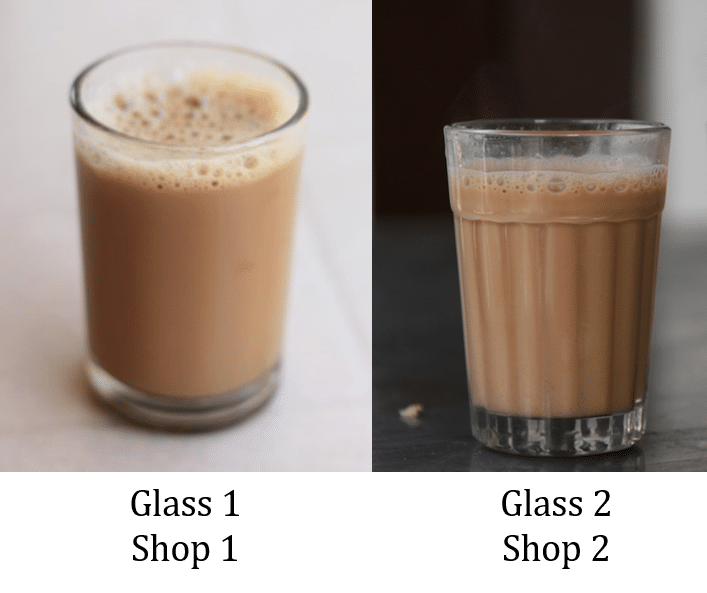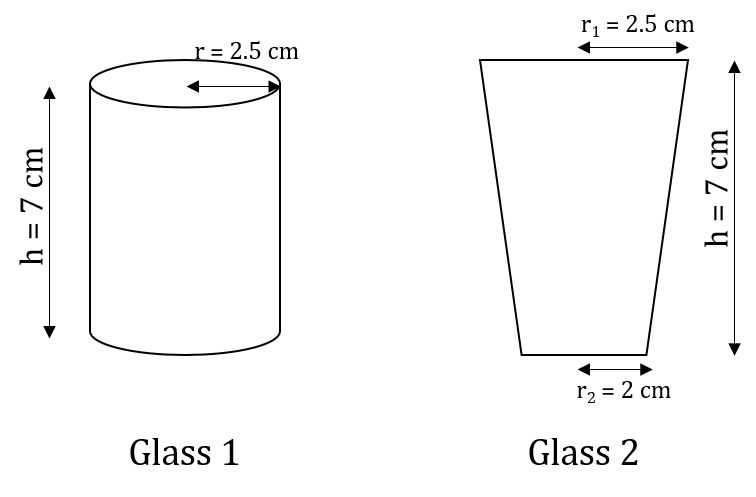There are two tea shops in the friendly neighbourhood around our office. Shop 1 has been our only option for coffee/tea for the last few years. We discovered shop 2 over the last couple of weeks. The taste of tea in both shops is comparable. However, the shape of the tea glasses amused me enough to spend some cognitive space on a scientific analysis.
The shapes of the tea glasses used by both shops are represented in Figure 1.

Figure 1 – shapes of tea glasses in shops 1 and 2
Glass 1 is shaped like a cylinder, glass 2 is shaped like the frustum of a right circular cone. The heights of both glasses are same. This observation led me to make some calculations of basic geometry. Figure 2 shows the schematic diagrams of glass 1 and glass 2.

Figure 2 – schematic geometrical diagrams of glasses 1 and 2
Calculation of Volumes:
Glass 1 –
Height h = 7 cm
Radius r = 2.5 cm
| Volume of glass 1 | = | Volume of cylinder |
| = | πr2h cm3 | |
| = | 3.14 x (2.5)2 x 7 cm3 | |
| = | 137 cm3 |
Glass 2 –
Height h = 7 cm
Radius r1 = 2.5 cm
Radius r2 = 2 cm
| Volume of glass 2 | = | Volume of frustum of cone |
| = | 1/3πh (r12 + r22 + r1r2) cm3 | |
| = | 1/3 x 3.14 x 7 ((2.5)2 + 22 + 2.5×2)) cm3 | |
| = | 112 cm3 |
Comparison of cost:
For the sake of calculation, let us equate the volume of the solid to the volume of the liquid it holds. Glass 1 holds 137 ml of tea and glass 2 holds 112 ml of tea. Shop 1 sells one glass of tea for 10 Rs, shop 2 sells one glass of tea for 7 Rs. Therefore shop 1 sells 13.7 ml of tea per rupee and shop 2 sells 16 ml of tea per rupee.
Mathematics tells us that drinking tea at shop 2 is more cost effective. The facts that shop 2 is just two doors down the road and delivers to our office form the icing on the cake.
Why go to all this trouble?
The decision to drink tea at one shop or the other is a matter of convenience and personal choice. Also, common sense can tell us which tea is more cost-effective. However, using basic Mathematics to arrive at this conclusion was a cognitive exercise that I thoroughly enjoyed.
Look around you. Find ways to use your subject knowledge to amuse yourself. Better still, encourage your children to do the same. The next time a child asks you, “where will I use all these mathematical formulae in my life?”, throw a similar problem for them to solve. When learning becomes amusing, you can’t draw the learner away from it.
We at NumberNagar® strive to connect concepts that children learn in schools to their everyday life. As facilitators, we take pleasure in practising what we preach. This is one part of my job that I love.
Image credits:
Featured image – Pixabay
Figure 1 – Reference 1 Reference 2
Dr. Soumya Sreehari
Latest posts by Dr. Soumya Sreehari (see all)
- To drink water or not to drink – that is the question - 11 June 2021
- Puzzles for fun and learning - 28 May 2021
- A questioning mind is a thinking mind - 14 May 2021
- Play and learn having fun with words - 7 May 2021
- 4 lessons to learn from the Montessori method - 30 April 2021


Wowwwwww…simply superb…I love math…but I never knew I can set an example like dis in our daily activities too…..ur just like young Sheldon….
Thank you, Lavanya… So glad you liked it… Yes, Maths is everywhere… We need to look for triggers… Thanks for the young Sheldon compliment 🙂
Wow Wow Wow! Being a mathematics learner myself and always wanting to show the esence of mathematics through reality , it truly amazes and inspires me to see this beautiful articulation and knowing that I have people around me who can help me achieve this way of communicating mathematics to the world. I bow to you ma’am.🙇🏻♀️
Thank you, Neha. So happy that you could relate to it. Keep the learning spirit up and keep looking, you’ll find like minds. 🙂
Really Experiential Learning about life
Thank you very much. Glad you liked it.
I enjoyed it. Practical maths 👍 thanks Soumya
Thank you, Princy. Glad you liked it and really happy you commented. 🙂
Truly amazing! We blindly pick outlets to eat & drink but very rare do such thoughts come that are simple yet provoking!
This was indeed an excellent approach – good to know that side too.
Thanks, Ranjini.
A wonderful approach to show we apply these formulae in day today life.
Thanks, Sudha.
Lovely way to compare.. liked it. I always wonder what is the use of all these formulas. I never enjoyed maths. May be now I shall start enjoying with my kids all over again.
Thank you, Vaishali. That’s the spirit! Enjoy with your children.